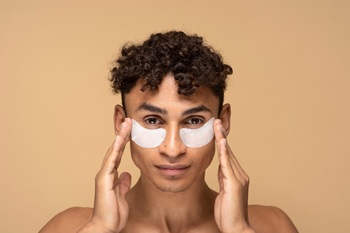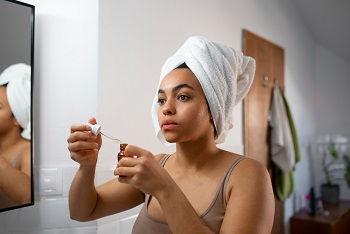Understanding Eye Bags and Dark Circles: Causes and Effective Treatments
Eye bags and dark circles are prevalent aesthetic concerns of individuals of all ages. Although generally harmless, these conditions can significantly impact one’s appearance and self-esteem. While dark circles and eye bags are often used interchangeably, they refer to different issues with distinct causes.
Dark circles pertain to the pigmentation under the eyes, which is usually darker. Eye bags denote the puffiness or swelling in that area. These concerns can be genetic, lifestyle choices, or physiological changes. This article explores the causes, prevention strategies, and treatment options for eye bags and dark circles, offering insights on effectively managing and reducing their appearance.
6 Causes of Dark Circles and Eye Bags
Several factors contribute to the appearance of dark circles and eye bags. Understanding these causes can provide insight into effective management strategies.
Ageing and Skin Thinning
Collagen and elastin levels decrease as we age, resulting in thinner skin. This makes the blood vessels under the eyes more visible, creating a darker appearance. Additionally, the loss of fatty tissue in the under-eye area can lead to hollowness, which increases the appearance of dark circles (1).
Genetics
Some people are genetically predisposed to have darker pigmentation under their eyes. If dark circles or eye bags run in your family, you may be more likely to develop them, regardless of other lifestyle factors.
Lack of Sleep and Fatigue
Sleep deprivation can cause the skin to appear paler, making dark circles more noticeable. Fatigue can also lead to fluid accumulation in the under-eye area and result in eye bags (2).
Allergies and Sinus Congestion
Allergies trigger the release of histamines, leading to itching, swelling, and dilated blood vessels around the eyes. Sinus congestion also causes blood vessels to become more prominent, intensifying dark circles and puffiness.
Sun Exposure
Exposure to the sun increases melanin production, which can darken the skin under the eyes. Sun damage is particularly prevalent in this area, as the skin is thinner and more vulnerable to UV rays (3).
Dehydration
Dehydration can cause the skin to appear dull and thin, which makes dark circles more pronounced. Hydrated skin is typically plumper, reducing the visibility of underlying blood vessels.
How to Prevent and Reduce Dark Circles and Eye Bags
While you may not be able to control every factor, there are strategies to help prevent and reduce the appearance of dark circles and eye bags.
Prioritise Sleep
Adequate sleep is one of the most effective ways to reduce eye bags and dark circles. Aim for 7-9 hours of sleep per night to ensure your body and skin have time to rejuvenate.
Protect the Skin from UV Rays
Use a sunscreen or eye cream with SPF to protect the under-eye area from UV damage. Wearing sunglasses can also prevent sun exposure and protect the delicate skin around the eyes.
Stay Hydrated
Drinking enough water is essential for skin health. Staying hydrated helps maintain skin plumpness and elasticity, which can minimise the appearance of dark circles (4).
Use Gentle Skincare
Applying eye creams or serums with antioxidants, hyaluronic acid, and vitamin C can help brighten the under-eye area and promote skin repair. Avoid harsh chemicals or aggressive rubbing to avoid irritation and thinning the skin.
Address Allergies Promptly
You can manage allergies with antihistamines or natural remedies to reduce the puffiness and dark circles associated with histamine release. Avoid rubbing your eyes, as this can further damage the delicate skin and worsen dark circles.
Treatment Options for Eye Bags and Dark Circles
While prevention is key, effective treatments are available to reduce the appearance of dark circles and eye bags.
Topical Treatments
- Retinoids: Retinoids stimulate collagen production, which can help thicken the skin and reduce dark pigmentation. However, retinoids should be used cautiously in the under-eye area and are best applied under medical guidance (5).
- Vitamin C: This antioxidant brightens the skin and may reduce hyperpigmentation by inhibiting melanin production.
- Caffeine-Based Creams: Caffeine is a vasoconstrictor that can temporarily reduce the appearance of dark circles and puffiness by shrinking blood vessels.
Chemical Peels
Mild chemical peels containing glycolic or lactic acid can help remove pigmented skin cells, brightening the under-eye area. A trained professional performs chemical peels to avoid irritating and damaging the delicate eye area.
Laser Therapy
Laser treatments, such as fractional lasers, are effective for addressing pigmentation and improving skin texture. They work by targeting melanin and stimulating collagen production. Dermatologists typically administer treatments and require a few sessions to see results (6).
Microneedling
Microneedling involves tiny needles that create micro-injuries in the skin, promoting collagen production and improving skin thickness. When combined with serums like hyaluronic acid, microneedling can enhance the plumping and brightening effect in the under-eye area.
Dermal Fillers
Fillers, typically made of hyaluronic acid, can fill in hollow areas under the eyes, reducing shadowing and the appearance of dark circles. While fillers offer immediate results, they are a temporary solution and usually repeated every 6-18 months, depending on individual needs.
Cold Compresses and Ice Rollers
A cold compress or ice roller can reduce puffiness by constricting blood vessels. Cold therapy is a quick, affordable, temporary solution for eye bags and puffiness. (7).
Lifestyle Tips to Maintain Bright, Healthy Under-Eye Skin
Here are a few lifestyle habits that can make a long-term difference in the appearance of the under-eye area:
- Maintain a Balanced Diet: A diet rich in antioxidants, vitamins, and minerals supports skin health and reduces inflammation. Vitamin E, C, and omega-3 fatty acids in foods like berries, nuts, and fish are especially beneficial.
- Limit Alcohol and Caffeine Intake: Excessive alcohol and caffeine consumption can dehydrate the skin, which exacerbates the appearance of dark circles and eye bags.
- Exercise Regularly: Exercise increases circulation and promotes overall skin health. Improved blood flow can help reduce the visibility of blood vessels under the eyes.
- Avoid Smoking: Smoking breaks down collagen and causes premature ageing, increasing the risk of dark circles and under-eye puffiness.
Conclusion
Dark circles and eye bags are common aesthetic concerns of people of all ages. While generally harmless, these conditions can significantly impact one’s appearance and self-esteem. While several factors can be responsible for these concerns, there are effective treatments and at-home remedies you can use to manage and effectively target each concern. Before using any products or treatment, speak with an expert such as a dermatologist for proper diagnosis and treatment.
Edited by: Damilola Elewa
Additional Read;
- What are the Benefits of Retinol to the Skin?
- The Latest Trends in Anti-Ageing Treatments and Skincare
- How Skin Microbiomes Influence Glowing Skin








Comments (0)